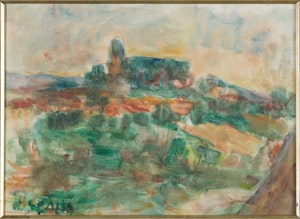Date
11 December, 2017
— April, 2018
Venue
The Suter Te Aratoi o Whakatū
Location
Nelson, New Zealand
Drawing from the Suter’s significant collection of British Modernist paintings and some star loans The Cornish Connection examines the creative links between Cornwall and New Zealand.
Excerpt from The Cornish Connection wall label by Julie Catchpole (Director):
"After showing early artistic promise the young Flora Scales was sent to Christchurch to boarding school so that she could attend the Canterbury College School of Art part-time. By 1906 she had started to show with the New Zealand Academy of Fine Arts. Her study continued with four years at the Frank Calderon’s School of Animal Painting in England. During this time it was likely she had lessons from Stanhope Forbes in Cornwall.
She returned to New Zealand and after her parents separated Flora, her mother and sister moved to Nelson to try to make a living as orchardists (unsuccessfully!). Upon her father’s death in 1928 Flora received a legacy and she was able to devote herself to art. Seeking further overseas tuition she tried Paris, but found the most fulfilling to be that offered at the Hans Hofmann’s School of Art in Munich in the winter of 1931-32.
Returning to Nelson in 1934, Scales was approached by Toss Woollaston who sought art instruction from her, thus receiving her interpretation of Hofmann’s principles of modernism (which he in turn shared with Colin McCahon).
During the Second World War Scales was interned in France for about two years and afterwards moved to England with her mother and sister.
In the 1950s she must have spent time in Cornwall, where by then her handling of paint is very loose and broad almost to the point of abstraction.
Eventually she was to return to New Zealand and had her first solo exhibition in 1975, organised by Colin McCahon, by which time she was in her eighties."
![Boarding House, St Ives, Cornwall [1] image](https://florascales.imgix.net/public/-093-img-BC06076-58--BC060-Brd-Hse,.jpg?ixlib=js-3.8.0&auto=format&w=300)
![Untitled [Mousehole Cornwall 2] image](https://florascales.imgix.net/76_65_ad.jpg?ixlib=js-3.8.0&auto=format&w=300)


